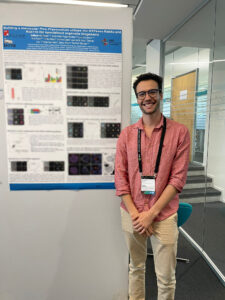Best poster prizes at ‘BioMalPar XXI: biology and pathology of the malaria parasite’
The EMBL Conference ‘BioMalPar XXI: biology and pathology of the malaria parasite‘ took place in May 2025 at EMBL Heidelberg and virtually.
This annual meeting provides an invaluable platform for scientists worldwide to convene, share critical insights, and explore cutting-edge technologies around the subject of malaria, united in the efforts against this persistent disease.
For the 21st edition of the conference, we had 200 people attending on-site and 30 participants joining us remotely. There were 18 fellowships provided by the EMBL Corporate Partnership Programme, EMBO, and other sponsors. With the total of 120 posters to view, we held two poster sessions during which the presenters could discuss their research — their work was then voted for by all participants. There were ten poster prizes awarded during the meeting. We are pleased to share with you nine of the winners’ abstracts!
Building a merozoite: how Plasmodium utilizes the GTPases Rab5a and Rab11b for specialized organelle biogenesis
Presenter: Guilherme Farias
Authors: Guilherme Farias, Nick Piwon, Paolo Mésen-Ramírez, Danny Wilson, TobiasSpielmann, Tim Gilberger

Centre for Structural Systems Biology (CSSB) / Bernhard Nocht Institute for Tropical
Medicine / University of Hamburg, Germany
Abstract:
Plasmodium ability to proliferate in red blood cells depends on the biogenesis of specialized organelles essential for merozoites invasion and egress. These organelles are generated de novo during the intraerythrocytic cycle (IDC) utilizing a tightly-regulated vesicle trafficking machinery. In Apicomplexa, this process appears to have evolved by rewiring of canonical endolysosomal factors. For instance, the Ras-associated protein 5a (Rab5a), a classic marker of early endocytic compartments in eukaryotes, was shown to be essential for apical organelle biogenesis in T. gondii. However, little is known about the role of this regulator in organelle biogenesis in Plasmodium falciparum. We employed the rapid knock-sideways (KS) system to inactivate Rab5a at different IDC timepoints. We found that early-stage KS caused schizogony arrest while KS at late stages did not affect parasite replication but led to a severe invasion defect, likely caused by an incomplete development of the rhoptries and micronemes, as evidenced by ultra-expansion microscopy. Next, we employed proximity labelling by DIQ-BioID to identify the Rab5a interactome and provide mechanistic insights into this pathway. We identified vesicle fusion and tethering proteins such as SNARES, HOPS/CORVET and a VPS9 domain containing protein. We confirmed the intimate contact between Rab5a and this tethering complex by reciprocal BioID using one core subunit of HOPS/CORVET. Interestingly, VPS9 KS disrupted the intracellular localization of Rab5a and mimicked the rhoptry and microneme defect of Rab5a-KS suggesting a conserved role of VPS9 as a Rab5a activator. Despite its essentiality for schizogony and invasion, Rab5a KS did not affect segmentation and inner membrane complex (IMC) biogenesis, indicating regulation by a Rab5a-independent pathway. A candidate regulator of this pathway is Rab11b, was shown to be involved in IMC biogenesis in T. gondii. Utilizing the KS system, we found that Rab11b inactivation lead to segmentation and IMC formation defects, demonstrated by an abnormal localization of the IMC marker IMC1c. Altogether, our data elucidate specialized endolysomal pathways responsible for merozoite organelle biogenesis, with Rab5a regulating the development of rhoptries and micronemes and Rab11b segmentation and IMC biogenesis.
Due to the confidentiality of the unpublished data, we cannot share the poster
Optimising vaccine design to the Plasmodium falciparum merozoitesurface protein MSP2 by characterising antibody epitopes and functions
Presenter: Timothy Ho
Authors: Timothy Ho, Adam Thomas, Tom Ruenz, Linda Reiling, Lee Yeoh, James Kazura,Arlene Den, Kiprotich Chelimo, James Beeson, Colin Pouton

Burnet Institute / Monash University, Australia
Abstract:
There is a strong need for highly efficacious next-generation vaccines for malaria. One strategy to improve vaccine efficacy is to more effectively target protective epitopes and incorporate epitopes from multiple antigens into a single vaccine. Here, we identified a promising region in the merozoite protein MSP2 that is targeted by protective antibodies and is suitable for vaccine development. We studied epitopes and effector functions of antibodies targeting MSP2, an abundant merozoite surface protein of P. falciparum that is a prominent target of acquired antibodies associated with protection from malaria. Testing samples from immune Kenyan adults, we identified a region in both major allelic families of MSP2 that is strongly targeted by IgG and IgM. Notably, antibodies to this region effectively activated key mechanisms of immunity to blood-stage malaria — the complement pathway and opsonic phagocytosis. A strong correlation between IgG and functional assay readouts further suggests that IgG to this region is crucial for protective functional activity. Detailed analysis of epitopes within this region revealed that immune individuals generate responses to different, but adjacent, epitopes. Therefore, vaccines must be designed to include all key epitopes to maximise protection at a population level. Our method of optimising vaccine design based on antibody isotype and function, epitope characterisation, and allelic variation represents a significant step forward from previous MSP2 vaccine trials, which employed full-length recombinant proteins. To this end, we have translated our findings into mRNA and peptide-based vaccines. In mice, these vaccines induced favourable IgG subclass profiles and mediated relevant functional activity. Our findings suggest that a key region of MSP2 could be targeted in vaccine design to generate potent protective antibodies using the mRNA platform or other approaches. This strategy of identifying and targeting protective epitopes can also be applied to other blood-stage proteins, facilitating the development of highly efficacious multi-antigen vaccines.
Due to the confidentiality of the unpublished data, we cannot share the poster
Targeting protein aggregates: a novel strategy for malaria treatment
Presenter: Claudia Camarero – Hoyos
Authors: Claudia Camarero-Hoyos, Inés Bouzón-Arnáiz, Antonino Nicolò Fallica, Ana Mallo-Abreu, Samuel Pazicky, Zbynek Bozdech, Diego Muñoz-Torrero, Yunuen Avalos Padilla, Xavier Fernàndez-Busquets

Institute for Bioengineering of Catalonia (IBEC), Spain
Abstract:
The rapid evolution of drug resistance in Plasmodium is rendering current antimalarial treatments ineffective. Consequently, new drugs that exploit previously untargeted weaknesses in the pathogen are urgently required. Protein aggregation is a prominent feature across all life stages of the malaria parasite, and its disruption has been observed to impair the viability of Plasmodium falciparum, suggesting a critical, yet poorly understood, role in the parasite’s biology. The recently developed bis(styrylpyridinium) salt YAT2150, which targets protein aggregates, exhibits potent antiplasmodial activity in the two-digit nanomolar range, even demonstrating efficacy against drug-resistant strains. YAT2150 treatment reduces protein aggregation within the parasite, a phenomenon potentially linked to its mechanism of action. This effect has also been observed with other antimalarials of aminoquinoline nature, despite having a widely different chemical structure. Altogether, YAT2150 represents a promising lead compound for a new class of antimalarials targeting functional protein aggregates, offering a novel approach to malaria therapy. In order to identify specific proteins affected by YAT2150, several strategies are being explored at the moment, which could shed light onto key players of the parasite’s survival. As no in vitro resistance has emerged against the compound, a combination of pull-down assays coupled with proteomic analysis, Cellular Thermal Shift Assays (CETSA), and transcriptomic analysis are being employed. This will enable us to generate a comprehensive picture of YAT2150’s targets, as well as of its downstream effects. Once potential targets are narrowed down, their functional validation will be carried out by generating knockout and truncated P. falciparum parasite lines. The multi-faceted approach here presented to study YAT2150’s targets, combining biochemical, genetic, and cell biological techniques, will provide crucial information about its mechanism of action. This will help gain insight into the broader significance of protein aggregation in Plasmodium biology, ultimately paving the way for the development of novel antimalarial strategies.
A novel immunotherapeutic strategy to interfere with Plasmodium falciparum pathogenicity and transmission
Presenter: Asrar Ba Ashn
Authors: Asrar Ba Ashn, Chen-An Yeh, Samhita Das, Antoine Claessens, Martin Larsen, Benoit Gamain, Olivier Silvie, Arnaud Chêne

Sorbonne Université, INSERM – CNRS, Centre d’Immunologie et des Maladies
Infectieuses, France
Abstract:
Despite significant progress in the development of malaria vaccines and anti-malarial drugs, the constant emergence of resistance to existing treatments threatens current control strategies. This growing threat underscores the urgent need for innovative therapeutic approaches to circumvent treatment failures and prevent spreading of drug-resistant parasites. Our group has developed an immunotherapeutic strategy based on bi-modular fusion proteins (BMFPs) that redirect a pre-existing Epstein-Barr virus (EBV) antibody response toward specific target cells, an approach that has demonstrated efficacy against cancer cells. In this study, we aim to adapt this technology to develop second-line treatments to reduce malaria pathogenicity and prevent the transmission of drug-resistant parasites. This will be achieved by targeting P. falciparum proteins expressed on the surface of infected erythrocytes or sexual parasite forms. BMFPs will consist of a Nanobody-based binding domain that specifically recognizes parasite antigens, fused to the EBV antigen P18F3, enabling the recruitment of circulating endogenous anti-P18F3 IgG to trigger diverse immune effector mechanisms in the human body or act as neutralizing agents in the Anopheles mosquito midgut to interfere with transmission. We generated Nanobodies targeting CX3CL1-binding proteins 1 and 2 (CBP1 and CBP2), expressed on the surface of erythrocytes infected by both sexual and asexual parasite forms, and Pf230, expressed on the surface of gametocytes and gametes. These Nanobodies were fused to P18F3 to create BMFP therapeutic candidates, which were then subjected to in-depth biochemical characterization using surface plasmon resonance to assess their binding affinity to their respective targets. To establish a murine in vivo model for evaluating the efficacy of these BMFPs in clearing infected erythrocytes or blocking parasite transmission, we generated two types of transgenic P. berghei parasites. One expressing P. falciparum CBP1 or CBP2 and one in which the D1 domain of Pb230 was substituted with the corresponding Pf230-D1 domain. These genetic modifications did not affect parasite transmissibility, thereby validating our investigative tools for the upcoming therapeutic efficacy study.
Mechanistic insights in transmission-reducing immunity revealed by cryo-EM structure of full-length Pfs230:Pfs48/45 complex bound to potent antibodies
Presenter: Ezra Bekkering
Authors: Ezra Bekkering, Randy Yoo, Fabian Heide, Sophia Hailemariam, Danton Ivanochko, Matthew Jackman, Nicholas Proellochs, Rianne Stoter, Oscar Wanders, Renate van Daalen, Maartje Inklaar, Carolina Andrade, Pascal Jansen, Michiel Vermeulen, Teun Bousema, John Rubinstein, Taco W.A. Kooij, Matthijs Jore, Jean-Philippe Julien

Radboud University Medical Center, The Netherlands
Abstract:
The fertilization of a female macrogamete by a male microgamete within the mosquito midgut is a crucial bottleneck in the life cycle of Plasmodium spp.. Transmission-blocking vaccines aim to induce immune responses to block critical processes before, during, or shortly after this fertilization event, preventing human-to-mosquito malaria transmission. The current leading transmission-blocking vaccine candidates target the proteins Pfs230 and Pfs48/45, both playing essential roles during fertilization. Pfs230 is retained on the gamete plasma membrane by forming a stable complex with the GPI-anchored Pfs48/45. Relatively little is known about the molecular assembly of the Pfs230:Pfs48/45 complex, or how Pfs230:Pfs48/45-targeted antibodies block malaria transmission. Here, we report the cryo-EM structure of the endogenous Pfs230:Pfs48/45 complex, purified from P. falciparum gametocytes, bound to six potent transmission-blocking antibodies. In the presented structure, the domains of Pfs230 assemble in multiple domain clusters, which are rigidified by inter-domain interactions mediated by insertion domains. Pfs48/45 forms a disc-like structure and interacts with a short C-terminal peptide of Pfs230, which is critical for Pfs230 membrane retention in vivo. We elucidated three potent new epitopes on the surface of the Pfs230:Pfs48/45 complex, including two potent Pfs230 epitopes outside domain 1, till very recently thought to be the only domain that could elicit transmission-blocking immunity. Our structural insights on complement-dependent Pfs230 antibodies provide a paradigm that explains differences in their transmission-reducing activity, where efficient in vitro complement deposition was found to be dependent on the angle of approach of the antibody. Mobility shift assays and in vitro gamete binding assays combined with structural analyses reveal that some Pfs48/45 targeted antibodies can disrupt the Pfs230:Pfs48/45 interaction, but that this does not correlate with transmission-reducing activity. Altogether, our Pfs230:Pfs48/45:antibody complex structure improves our understanding of malaria transmission biology and the mechanisms of action of transmission-blocking antibodies, and will inform the development of next-generation transmission-blocking interventions.
A potent acyclic nucleoside phosphonate inhibits the malaria cGMP dependent egress pathway via a unique mechanism of action
Presenter: Rea Dura
Authors: Rea Dura, Marie Ali, Marc-Antoine Guery, Emma Colard-Itté, Thomas Cheviet, Léa Robresco, Laurence Berry, Catherine Lavazec, Antoine Claessens, Suzanne Peyrottes, Kai Wengelnik, Sharon Wein, Rachel Cerdan

University of Montpellier, France
Abstract:
With malaria claiming around 600,000 lives in 2023 (WHO World Malaria Report, 2024) and resistance to current therapies surging, the demand for novel antimalarial strategies has never been more urgent. Following in vitro drug screening, we observed that UA2239, an acyclic nucleoside phosphonate (ANP) and purine analog, exhibits potent, multi-stage activity against Plasmodium falciparum, effectively arresting parasite growth. By irreversibly blocking merozoite and gamete egress from erythrocytes, UA2239 prevents further invasion and disease progression. To investigate the molecular target of UA2239, we generated P. falciparum lines resistant to the compound. Whole-genome sequencing of these lines identified mutations in the cGMP-dependent protein kinase (PKG) pathway, a well-characterized regulator of parasite egress. However, biochemical assays revealed that UA2239 does not directly inhibit PfPKG activity. Instead, our data suggest that UA2239 disrupts cGMP homeostasis by targeting guanylate cyclase (PfGCα), the sole enzyme responsible for cGMP synthesis in the parasite. This disruption leads to the depletion of intracellular cGMP levels, ultimately preventing the activation of the essential cGMP-PKG egress cascade. By blocking this critical signaling pathway, UA2239 introduces a first-in-class mechanism of action distinct from currently available antimalarials. Its ability to impair both blood-stage replication and transmission stages highlights its potential as a promising candidate for future therapeutic development. This study provides new insights into the essential cGMP-dependent egress process in Plasmodium and paves the way for further exploration of guanylate cyclase as a viable drug target.
Due to the confidentiality of the unpublished data, we cannot share the poster
A high-throughput screen identifies multiple druggable targets inPlasmodium falciparum transmission stages
Presenter: Leonie Seefeldt
Authors: Leonie Seefeldt, Christin Gumpp, Jerôme Eberhardt, Armin Passecker, Kleopatra Sifoniou, Basil Tino Thommen, Sylvia Boltryk, Judith Straimer, Thierry Diagana, Leila Alexander, Markus Lill, Christof Gruering, Matthias Rottmann, Till Voss4 Nicolas Brancucci

Swiss Tropical and Public Health Institute / University of Basel, Switzerland
Abstract:
Most anti-malarial drugs fail at targeting the parasite’s sexual transmission stages, the male and female gametocytes, endangering current and future efforts to eliminate or eradicate malaria. To identify gametocytocidal drugs, we developed and used a high-throughput drug screening platform that is based on inducible gametocyte-producing (iGP) P. falciparum parasites. In these iGP cells, sexual commitment is triggered via the overexpression of gametocyte development protein 1 (GDV1), allowing for the mass production of highly synchronous gametocytes and thereby enabling the screening of over 40,000 compounds per day for gametocytocidal activity. Through the screening of diversity-oriented and mode-of-action libraries, we identified 48 molecules that effectively eliminate mature gametocytes at low nanomolar concentrations. Focusing on three highly potent and chemically tractable compounds, we employed resistance selection, whole-genome sequencing, and drug-target interaction modeling to uncover their molecular targets. Our findings reveal three distinct malaria transmission-blocking drug targets and highlight a critical vulnerability of mature gametocytes to proteostasis-targeting mechanisms.
Due to the confidentiality of the unpublished data, we cannot share the poster
Functional study of the apical polar ring (APR) in Plasmodium falciparum
Presenter: Pratima Gurung
Authors: Pratima Gurung, Jeffrey Dvorin

Harvard Medical School / Boston Children’s Hospital, United States of America
Abstract:
Malaria is a life-threatening disease caused by Plasmodium falciparum, an apicomplexan parasite. It claims over half a million lives annually and primarily affects young children and pregnant women. The increasing resistance to frontline antimalarial drugs necessitates new therapeutic approaches. Our research focuses on the apical polar ring (APR), a conserved and crucial structure in apicomplexan parasites that represents an ideal target for novel, parasite-specific drugs. The APR marks the apex of the parasite’s unique cytoskeleton, known as the inner membrane complex (IMC), and serves as an anchoring site for subpellicular microtubules (SPMTs). The APR and associated cytoskeletal networks (SPMTs and IMC) are crucial for maintaining the parasite’s shape and facilitating fundamental processes such as daughter cell formation and host cell invasion. Despite its significance, the molecular components and functional role of the APR in P. falciparum remain poorly understood. Using reverse genetics and advanced microscopy techniques, we have identified and characterized PfAPR1 as the first known APR-resident protein in P. falciparum. Preliminary findings reveal that PfAPR1 is essential for the parasite’s asexual replication. We hypothesize that PfAPR1 and its interacting partners play pivotal roles in maintaining cytoskeletal integrity and enabling host cell invasion. To test this hypothesis, we will employ a multi-pronged approach combining molecular and cell biology methods, ultrastructural expansion microscopy, and proteomics. This study will provide insights into the poorly understood aspects of Plasmodium APR biology and open new avenues for developing antimalarial therapeutics targeting Plasmodium-specific structures.
Due to the confidentiality of the unpublished data, we cannot share the poster
Deciphering extracellular vesicles as a mode of communication between an intracellular malaria parasite and human host
Presenter: Madhavi Sanjay Shukla
Authors: Madhavi Shukla, Dr. Suchi Goel, Reetesh Raj Akhouri

Indian Institute of Science Education and Research (IISER) Tirupati, India
Abstract:
Severe malaria pathogenesis, driven by Plasmodium falciparum, is linkedto cytoadherence, where infected erythrocytes (IEs) bind to hostendothelial receptors, causing microvascular obstruction. Extracellularvesicles (EVs) released by P. falciparum-infected red blood cells (iRBCs)are implicated in intercellular communication, immune modulation, andgametocytogenesis, yet their role in cytoadherence remains unexplored.Our study investigates how EVs derived from cytoadherent (FCR3) andnon-cytoadherent (3D7) parasite strains modulate IE-host cell interactionsand the molecular mechanisms involved. Our findings show that EVs fromcytoadherent parasites enhance cytoadherence by altering the host cell’ssignaling pathways, like the MAP Kinase pathway. By reprogramming hostcell signaling and activating downstream transcription factors like c-Jun,EVs upregulate host cell adhesion molecules, i.e., endothelial cell surfacereceptors like ICAM-1 that promote iRBC binding to the endothelialsurface. This study provides new insights into the molecular mechanismsunderlying parasite-host communication, demonstrating that EVs play anactive role in modulating host cell properties to facilitate the adherence ofiRBCs
.
Find out more about the #EMBLMalaria conference from the blog post written by Alessia Hysa, who participated as an event reporter!
The EMBL Conference ‘BioMalPar XXI: biology and pathology of the malaria parasite‘ took place from 20 – 22 May 2025 at EMBL Heidelberg and virtually.